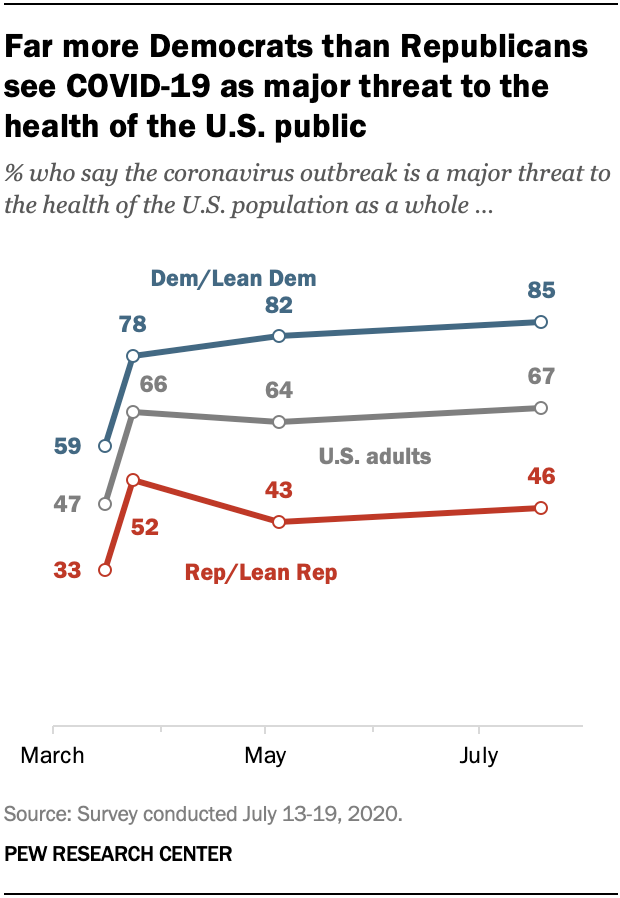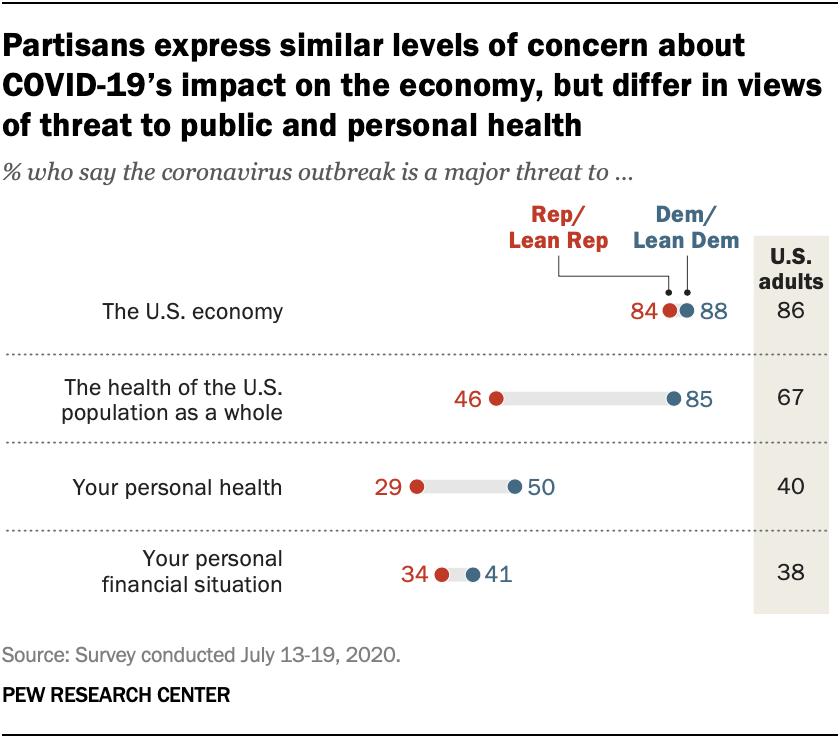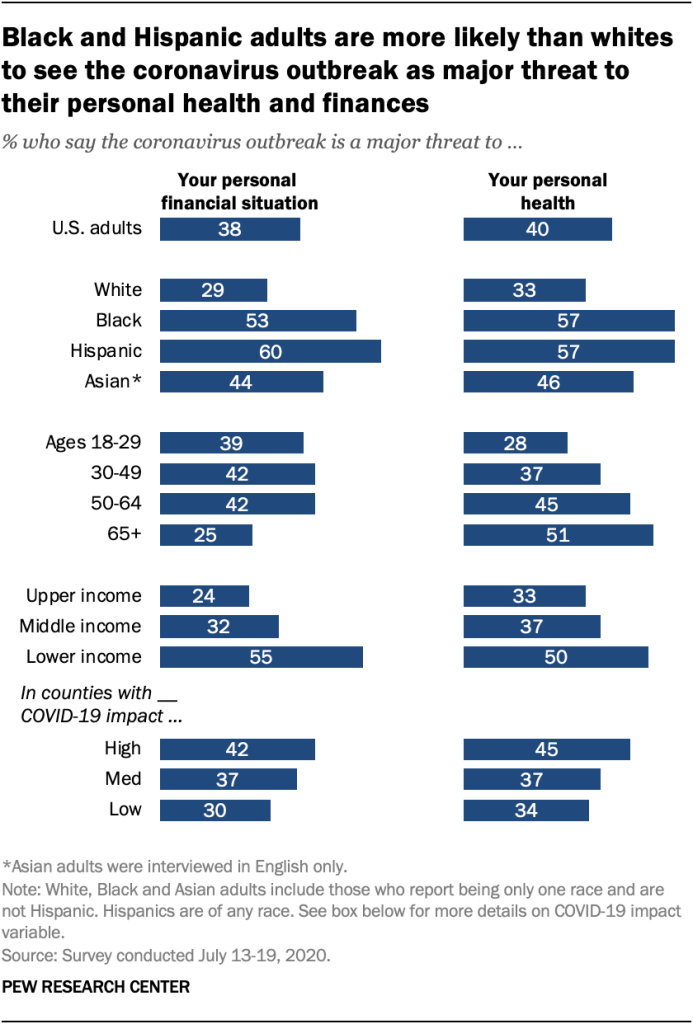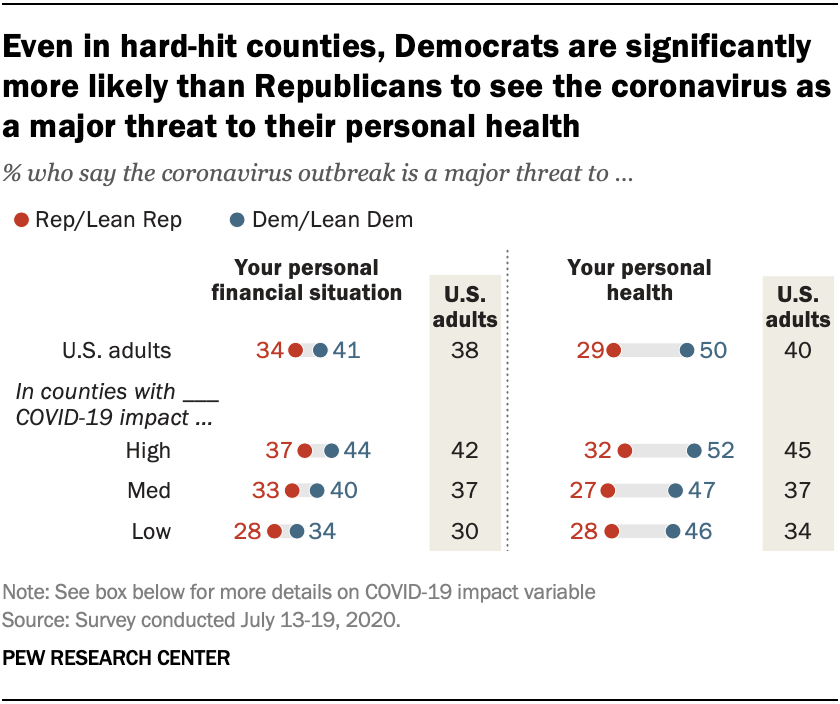With the number of COVID-19 cases and deaths on the rise in the United States, Republicans and Democrats remain far apart in their views of the threat to public health posed by the coronavirus outbreak. More than eight-in-ten Democrats and those who lean toward the Democratic Party (85%) say the coronavirus is a major threat to the health of the U.S. population. Republicans and Republican leaners see the disease in less serious terms: About as many Republicans say the coronavirus is a major threat to public health (46%) as say it is a minor threat (45%).
The gap between Republicans and Democrats in perceptions of the public health threat posed by COVID-19 is about the same as it was in early May, before cases surged in a number of states, including Alabama, Arizona, Florida, South Carolina and Texas. The partisan gap was somewhat smaller during the early stages of the outbreak in the U.S. in mid-March.
Views of the economic threat posed by COVID-19 are similar across both partisan coalitions, according to the survey, conducted July 13 to 19. Overall, 86% of Americans – including 88% of Democrats and 84% of Republicans – now view the coronavirus outbreak as a major threat to the U.S. economy. Concern over the outbreak’s economic impact has remained very high since the spring, when unemployment claims surged and the country’s 11-year economic expansion came to an end.
Pew Research Center has been tracking public reactions to COVID-19, including differences in views between partisan and demographic groups, since the outbreak began to impact the nation in March. This analysis of Americans’ views of the threats posed by the coronavirus outbreak is based on a survey of 10,211 U.S. adults conducted from July 13 to 19, 2020. Everyone who took part is a member of Pew Research Center’s American Trends Panel (ATP), an online survey panel that is recruited through national, random sampling of residential addresses. This way nearly all U.S. adults have a chance of selection. The survey is weighted to be representative of the U.S. adult population by gender, race, ethnicity, partisan affiliation, education and other categories. Read more about the ATP’s methodology.
Here are the questions used for this report, along with responses, and its methodology.
By comparison, the public is less intensely concerned about potential personal-level impacts from the coronavirus outbreak, both in terms of health and finances.
Four-in-ten Americans say the coronavirus presents a major threat to their personal health; another 46% call it a minor threat. Similarly, 38% say it’s a major threat to their personal financial situation, while 43% see it as a minor threat.
Democrats and Democratic leaners are more likely than Republicans and Republican leaners to say COVID-19 presents a major threat to their own health and finances.
A separate Pew Research Center survey in June found that Democrats were far more likely than Republicans to say they are concerned about personally contracting or spreading COVID-19. The same survey found that Republicans have become less concerned about contracting or spreading the virus since April, even as concern among Democrats remains as high as it was in the spring.
While the coronavirus has affected Americans from all walks of life, public health data shows it has hit certain groups particularly hard, including Black and Hispanic Americans, older adults, those with preexisting conditions and those with work or living arrangements that put them in close proximity to people who frequently contact others.
These dynamics are reflected in levels of concern over the personal health and financial impacts of COVID-19.
Majorities of Black and Hispanic adults (57% each) view the coronavirus as a major threat to their own personal health. By contrast, 46% of English-speaking Asian Americans and just 33% of white adults say this. There are similar differences by race and ethnicity in concern over the outbreak’s impact on personal finances.
Lower-income adults are much more likely than middle- and upper-income people to see COVID-19 as a major threat to their own health and finances. For instance, 55% of lower-income adults say the outbreak is a major threat to their finances, compared with 32% of middle-income adults and 24% of upper-income adults. Upper- and middle-income earners are far more likely to consider COVID-19 a minor than major threat to their own finances.
Older adults remain more concerned than younger adults about the personal health impact of the coronavirus. About half (51%) of those ages 65 and older see it as a major threat to their personal health, compared with only 28% of those ages 18 to 29. When it comes to personal finances, the oldest adults express less concern: Just 25% of those 65 and older say the outbreak is a major threat to their finances, compared with roughly four-in-ten in all younger age groups.
Adults living in counties with 100 or more COVID-19 deaths as of July 15 express somewhat higher levels of concern about the personal impact of the coronavirus than those living in counties that have experienced less of an impact. Among those in high-impact counties, 45% say the coronavirus is a major threat to their personal health, compared with 37% of those living in medium-impact counties and 34% of those in low-impact counties. There is a similar pattern in levels of concern over the personal financial impact of COVID-19.
Still, partisanship matters far more than place. Democrats remain much more likely than Republicans to view the coronavirus as a major threat to their personal health, regardless of whether they live in counties that have experienced high, medium or low impacts from the outbreak. In fact, Democrats living in low-impact counties are 14 percentage points more likely than Republicans living in high-impact counties to say the coronavirus is a major threat to their own personal health (46% vs. 32%).
Note: Here are the questions used for this report, along with responses, and its methodology.
This analysis uses the number of deaths attributed to COVID-19 in each respondent’s county as a measure of the scale of the health impact of the outbreak for each individual in the survey. Counties are categorized as having a high, medium or low number of COVID-19 deaths.
Counties are classified as “high” if they had 100 or more deaths as of July 15, 2020. “Low” counties had fewer than 10. The remaining counties are classified as “medium” impact.
Data for deaths attributed to COVID-19 by county are taken from the 2019 Novel Coronavirus COVID-19 (2019-nCoV) Data Repository maintained at Johns Hopkins University (downloaded on July 20, 2020).
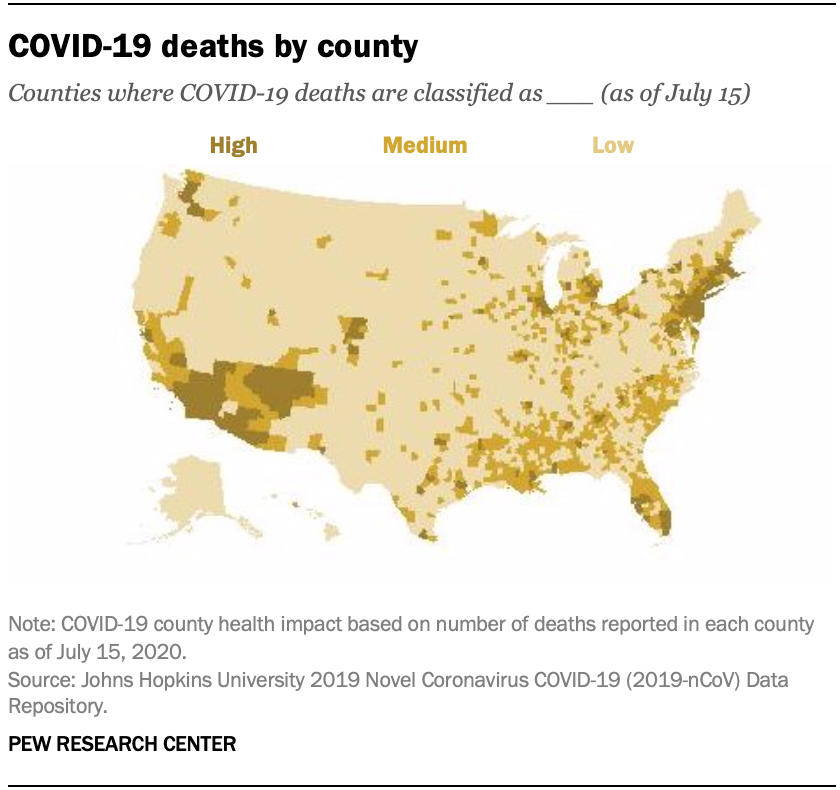
To create upper-, middle- and lower-income tiers, respondents’ 2018 family incomes were adjusted for differences in purchasing power by geographic region and for household size. “Middle-income” adults live in families with annual incomes that are two-thirds to double the median family income in the American Trends Panel (after incomes have been adjusted for the local cost of living and for household size). The middle-income range for the panel is about $37,500 to $112,600 annually for a three-person household. Lower-income families have incomes less than roughly $37,500, and upper-income families have incomes greater than roughly $112,600.
Based on these adjustments, among respondents who provided their income and household size, 34% are lower income, 45% are middle income and 21% fall into the upper-income tier.
For more information about how the income tiers were determined, please see here.
